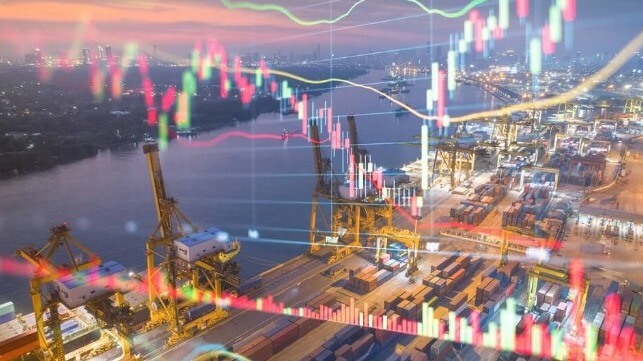Op-Ed: With Digitalization, the Human Role in Shipping is Changing
The systems and algorithms that will power up vessel efficiency can already ingest and process data faster than humans, says Silverstream's Nick Chrissos.

When it comes to data and digitalization, the shipping industry is following the well-established path of other sectors that have successfully incorporated technology and harnessed its potential for business advancement, says Nick Chrissos, Chief Digital & Information Officer of Silverstream Technologies.
The shipping industry now widely acknowledges the significance of the digital journey and the potential of data. The surge of interest in digital solutions in recent years indicates a shift from viewing data as ‘nice to have’ to recognizing it as a vital catalyst for driving industry transformation. It's no longer a matter of whether the industry will embrace digitalization and data, but rather when and how rapidly it will do so.
From costs to regulatory compliance, there are several influential factors driving this digital transformation and, in turn, the decarbonization transition. The upcoming European Emissions Trading System (EU ETS) spans both. Starting on January 1, 2024, the EU ETS puts a cost on emissions from commercial ships of 5,000 GT or more that call at EU ports. Initially, 40 percent of emissions are in scope, quickly ramping up to 70 percent for 2025, and to 100 percent for 2026 onwards. When factoring in this cost on emissions – and not to mention the additional extra costs that will come as regulation ramps up – the value proposition for clean and digital technologies, and the importance of leveraging data, is clearer than ever.
In this era of multi-tiered and complex climate regulations, actionable data has become a driving force behind both the industry's digital transformation and its decarbonization agenda. As a result, we are transitioning from an era where data was collected and stored passively, often leading to valuable insights being overlooked or forgotten, to a phase where data is being actively leveraged to inform business decisions and strategies.
Raising the roof
Looking specifically at clean technologies, in simple terms, data can and will be used by clean technology manufacturers to raise both the floor and ceiling of fuel-saving potential. Like the intelligent systems within modern cars that tune the vehicle’s engine as it drives, maritime clean technologies will learn and respond to their environment and operate in a way that ensures maximum efficiency.
Because clean technologies are deeply integrated into a vessel, there is the potential for them to identify and unlock efficiencies that others may not even know exist. In other words, they become active and intelligent solutions to maximize the performance of a ship.
The integration of Silverstream’s air lubrication system within the vessel’s ecosystem, for example, provides us with insights into a ship’s hydrodynamic performance. We can harness data from our system, as well as multiple sensors around the vessel, to gain an in-depth understanding of air lubrication technology and identify factors that could influence the ship’s overall performance.
It is also key to accurately calculate, measure, and report the efficiency level and decarbonization impact of clean technologies. This has always been a priority for Silverstream, and our air lubrication system reduces average net fuel consumption and GHG emissions by 5-10 percent. It does this by releasing a carpet of air under the ship’s hull to reduce the frictional resistance between the hull and the water.
Since its inception, Silverstream has only ever claimed system performance that we can prove. However, the digitalization of clean technology will allow for even more precision when sharing performance data. Monitoring and measuring performance data, as well as system health, will be an integral component of not just our clean technology, but all clean technologies, in the near future.
New thinking
The digitalization and data evolution is underway, but thinking about clean technologies in this way will require two key shifts in sentiment for shipping. These shifts are Silverstream’s big prediction for the next phase of maritime digitalization.
First, we will have to become acquainted with the human role changing, and with crew effectively being removed from active decision-making on some tactical elements of ship operation. The systems and algorithms that will power up vessel efficiency (and indeed routing, navigation, berthing and more) are already at the point where they ingest and process more information than a human can comprehend. Optimizing clean technologies even further will require trust in the machine learning (and soon-to-be artificial intelligence) systems that underpin them.
Secondly, and more significantly, shipping will have to change its technology outlook. Currently, technology – whether physical or digital, traditional or innovative – is generally seen as a means to fulfill the requirements of today, not to anticipate the future.
This is something that Silverstream has observed and educated the industry on with respect to proven clean technologies. Air lubrication is seen increasingly as a mainstream solution that helps operators keep their vessels flexible to the demands of the future, as well as improve efficiency today. We can collectively now do the same thing by applying data to all clean technologies.
We must continue to elevate our thinking about what proven technologies can do for ships, and develop a holistic vision of their impact. Fuel bills are cut, and emissions are reduced, certainly, but these technologies can be an even deeper enabler of change for shipping companies. Getting there is going to require a change in how we think about technologies and their impact on operations – and placing more trust in shipping’s digitalization pathway as a vector for genuine, lasting change.
Nick Chrissos is the Chief Digital & Information Officer of Silverstream Technologies.
The opinions expressed herein are the author's and not necessarily those of The Maritime Executive.
